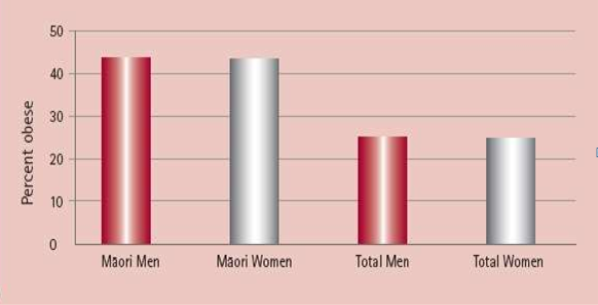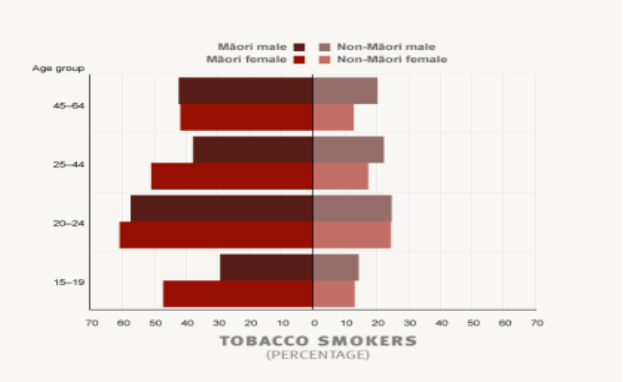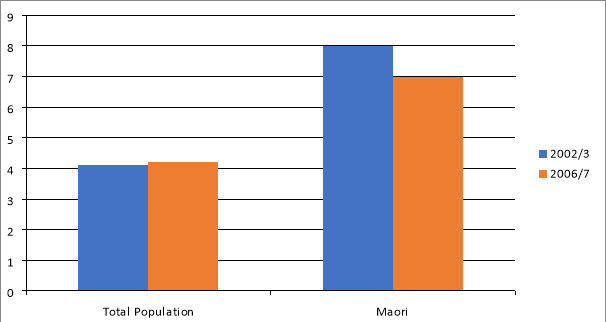Maori Trends and Paradigms 1919 to Present
Introduction
In this research its aims to focus on the component of the tamaki makarau maori and the suggestions of it to the kaupapa maori inquire about. Using the existing look into the research- I outlined three huge Haora maori patterns and the current matters that include obesity, diabetes and smoking.
The examination of Maori and non-Maori there have been 3 important contemporary issues is recorded, as follows:
Obesity:
- lifestyles – Fast food most widely consumed food in NZ, it costs low and taste good with no control has pulled in many Maori customer.
- Employment – in the mid-2000s, the Maori in New Zealand are paid less and they don’t have any other choices than just fast foods so they just eat junk food which contains large chunks of fat.
- Health Statistics – Obesity causes a lot of disease, which impacts the lives of Maori, for example, high blood pressure, cholesterol and coronary diseases.
Smoking:
- Health Statistics – smokers from second-hand smoker can affect the normal people, and tobacco kill 5,000 people every year in NZ each year.
- lifestyles – in mid-2000s, Maori females were more likely to smoke as the females in total population, and of Maori and Pacific men were 1.5 times more likely to smoke than the rest of the men population.
- Government policies – the mid-2000s, the government is considering the substantial issues and smoking are not to carry on Maori youth.
Diabetes (type 2):
- Health Statistics – in New Zealand, more than 240,000 individuals who are with diabetes, generally which is type 2. Additionally 100,000 pople aso has it but are not yet considered. Diabetes are more comon in maori and pacific islanders and o top of that they are 4 times more likely to have it than any other people in nz.
- Education – a large percentage of Maori individuals r absence form information and bad side of the diabetes, that cause them eat in an excessive amount of sugar in their every day life
- lifestyles – the fact that is in the diet patterns of the Maori people, they prefer to eat sweet dishes like sweets, drinks and unhealthy food.
In this research I likewise secured on the conventional ethic of Maori culture. Te Whare Tapa Wha, it develops with its solid establishments and 4 equivalent sides which speak to the image of the Wharenui show the four measurements of Maori wellbeing, which are:
- Whanau (family ): Maori Whanau rely on theiir quality to be identified and their ancestors, past relationships, is concerned with the present and future.
- tinana (physical well-being): Maori tinana rely on the external environment which supports them in their essence and homes,
- Hinengaro (mental well-being): it means how the maori people see themselves in the world.
- Wairua (Spiritual wellbeing): Maori individuals trust their wellbeing are identify with hidden and secrete energies, the conventional Maori search of physical signs of sickness will concentrate on the wairua to figure out if harm here could be a contributing components.
Additionally the key words (partnership, participation and protection) of the Treaty decided that the major parameters Korwai Oranga (Maori Health Strategy) are as follows:
- Partnership: gathering the hapu, iwi, whanau of the the maori groups as a one unit to creat suitable well-being and the facilities for the disable people and methodologies the well- being of maori’s
- Protection: to ensure the non-maori and maori are getting a similar sort of facilities.
- Participation:  Relating Maori into all stages of the service division. For example, include with basic leadership, self-awareness, delivery of wellbeing and handicap services.
Methodology;
The methods that I have used in a Kaupapa Maori, framework and every informations in this research methodoogy has got the information gathering from Internet, both meeting and survey to find about their way of life morals and woud result conference with nearby hapu/iwi.
- Internet : I gathered informations regarding the quantity of Maori families who experienced obesity, smoking and diabetes issue. Possible elements might identify with government procedures, ways of life (dietary patterns), education and employment. What government accomplished for enhances the circumstance, what is the outcome.
Literature Review
Obesity;
The definition of obesity is the high fats of mass and the body mass list(BWI) to the extent of at least 30. Lifestyle components, for example, sick health and absence of work, can directly have Serious medical problems, for example, diabetes and obesity. Obesity is related to a progression of well-being, counting different sorts of stroke, hypertension, kidney dieseas and diabetes. People with obesity are more likely to experience social, personal and emplymnt challenges.

In 2009, Ministry of Health research demonstrates that there are around 1.12 million New Zealanders are encountering obesity. The 2005and 2007 information, demonstrated that 26% of New Zealanders are obese, a slight ascent in 2001 and 2002, which are 23% however a more noteworthy appear differently in relation to 1998 (18%). In current examples, we continue with the rate of obesity in New Zealand will ascend to 27% in 2010. Between the ages of5 to 33, corpulence is more regular in man. Between the age of 64 to 75, ladies are more at hazard, then man to get large. Starting at 2003, there are over 31% of youngsters in New Zealand wound up as hefty. In 2009, there were 8.2% of youngsters named heftiness among youngsters between 6-15 years old. Since 2007, the New Zealand government has started managing stoutness to wipe out high-fat nourishments and high-sugar drinks from school cafeterias, and dispense with the advancement of garbage sustenance amid light hours. These exercises are noteworthy in directing the rate of extension of hefty individuals in New Zealand, especially among youngsters.
Smoking;
The first Europeans to bring tobacco smoke to New Zealand was in the late 1700s, it quickly got in the Maori community. The term smoking hikareti (eating cigarettes) and Momi hakareti (sucking cigarettes) are included. In mid 1800, Pakeha gun powder rifles, explosives, alcohol and tobacco uses and sevices arrangements for payment or as a gift were offerred to the Maori people. Indeed, even the heads of the village who marked the Treaty, were also given tobacco.
Since smoking is clearly accessible to the Maori’s people, it turned out to be more of substantial smoking and that habit wasn’t limited by sexual orientation or age, even Maori youth and youngsters additionally smoaked.
Ki Puke Hikurangi Te Maori daily paper in 1899, commented:
Discussing oncTobacco and cigarette. The tobacco is mostly abused by female, male and by youth groups. Päkehä’s rules for tobacco smoking is only by older men, and it is a proper age for starting tobacco, women and young women do not smoke at all by any means.
As it is known the tobacco’s effect on the health of a person, it may lead to diseases such as respiratory, coronary illness and cancers. Nevertheless, till mid-twentieth period the impact of the smoke on the Maori individuals remained unfamiliar because the data was scattered of the Maori’s health, tthe wellbeing framework for Maori was exceptionally restricted typically the reason for medical problem were not recorded. In 2010- 2012, there were 42% of Maori’s grown-ups smaoked .In 2009 Maori ladies aged between 20 to 25 had the most shocking percentage of smoking rate in New Zealand: total of 61%.
In mid twentieth period, there has been about few restriction to smoking amongst Maori. Groups such as rua kenna, tuhoe prohibited smoking, Maungapohatu. Maori Councils Act 1900 to enable the councils to prevent tobacco use by youngsters those providers.
Since 1999 the Maori group has focused onto quit of smoking. The smoking programs and has made initial progress. The people group likewise used the related programmes and for the most part accessible Quit line, there is more than 62% the smokers who are maori that were attempted to stop it in just 5 years of time till 2009. The record in 2011 demonstrates a drrop in beginning to start smoking in the maori youth. Many public places and schools got smoke free.

Diabetes
Type 2
The most common type of diabetes is type 2 diabetes. Diabetes is defines as a condition in the body when it cannot keep the blood sugar level normal. Compilations of diabetics include:
- High risk of having stroke or heart diseases.
- Blood vessels and nerve damage increases the chances of ulcers and the need for limb amputation.
- Damage to the blood vessels in the eyes which can lead to visual impairment.
- Damage to the kidneys, which causes kidney distress.
- It can induce some kind of nerve damage (diabetic neuropathy) and experience torment, tremors, weakness or numbness.
Unfortunately there isnt any known cure available for diabetes, however, you may lessen the danger of such issues jus by early diagnosis and get the suitable diabetess medications. In nz, maori grown ups are more likey than the other grown ups in the total number of population to have determined to have it, also theres countlss patients who are not disgnosed with diabetes.

The main cause of diabetes (type 2) in irregularities between food consumption and activity expenditure. The indirectly cases, which are more difficult to predict, incorporating the social, cultural and financial. (FVP, 2014)
At the beginning of the century, most of the maori do labour jobs, which implies that they have a huge amount of foood intake to get enough energy. That makes the Maori turn into fast food and makes the largest buyers, as a result of low wages rates and higher consumption of energy needs. In addition, there is absence of learning to seek for healthy and economical food, and culinary skills to get prepared healthy food. Poor eating habits are the originated by the parents than passed onto their kids.
Stated in Nz Heralad in 2006- Maori and Polynesians could be wiped out by the end of the century and the cause of it would be diabetes. The news is telling that western ways has controlled and have repaced the maori customs of the tradition, worsening the issue. The maori are 6 times more likely and the maori womens are 9 times more likely to die form frm diabetes than the nonpolynesians. From a study it was found that 126,000 new Zealanders were diagnosed with diabetes an 25% of that total were maori people. (NZherald.com, 2006 )
Analysis;
Obesity;
- Employment – Many Maori have moved to the city to seek for a better occupation and salary, however most of them are still low paid and doing heavy work, that consumes a lot of energy. To get it back with your limit wages, you have to choose from limited options just to fit a sizeable fast food measure. To earn more wages, Maori need to work overtime all the time. So do not have their meals on time and you do not get enough rest.
- Lifestyle: Most Maori do not have regular work and rest, work and lack of rest can cause hormonal differences. There are a large number of Maori individuals experiencing the harmful effects of obesity, which makes them feel this is normal health condition.
- Education – a large part of the Maori lack of education, because of the language barrier feel whakama and have no desire to ask for help with the issue of obesity. In addition they do not have the clear idea about the disadvantage of obesity, that can provoke problems of blood verses and hypertension and hyperglycemia. (minnestry of social development, 210)
Smoking;
- -Lifestyle: In light of the fact that most Maori begin smoking earrly, later it became their habit in their life, even they know that it is dangerous to their well-being and cannot be stopped for them. There’s a variety of issues that the effects of quitting, for example, work pressure, self-control abulia. In addition, the terrible temptation of relatives who ar substantial smokers is one of the fundamental issues. Theres no sexual or age impediment with the Maori uses of tobacco, which assembles an extremely distorting environment for most Maori.
- Education: Most Maori are of low educational and lack the harm of cigarette smoking in particular there are numerous children and pregnant women who smoke. What’s more, the child’s parents are busy with work, they do not have enough time to educate their children about the disadvantages of smoking and different disciplines.
- Goverrnment policies: the phase of colonization of crown using tobacco as a merchant with the Maori people. That caused numerous extreme uses of tobacco, as much the same as a great things for them. On the opposite side, the goverrnment is gets late to the points where it is possible to find the disadvantage of the smoking and progress of the quit of smoking project to the New Zealanders, non-maori and the maori. In addition, colonization of the crown are not banned among young people. People who consume tobacco that cause practically all of ages of people are distinctive and desire for tobacco. Because of this situation, there are three generations of Maori experiencing tobacco abuse. (MOH, 2011)
Diabetes;
- Education: Most Maori are low educated and do not know about diabetes. A large proportion of patients are diagnosed with diabetes Maori when the disease progresses to the most advanced stage. The goverrnment is not aware of diabetes information, people lack the awareness to get control of diabetes. On the opposite side, due to education problems, numerous Maori’s cannot speak in appropriate English which makes them feel disgraced when they have the interview or going to the specialist. The condition of diabetes has been disguised.
- Housing – early in the century, the Maori individuals lived closer to the forests, however after the colonization happened many of the young Maori moved to the towns and cities. The lifestyles of British conveys the gigantic impact on the maori health. For instance, the vast majority of their pay(wages) went on housing, so they can not afford the cost of their health and nutritional sustenance, so they become a major buyer of junk food.
- Lifestyle- After colonization, the Maori moved to the town or cities, they needed to make changes in their way of life to take after the mainstream. For instance, Maori’s eat numerous energy consuming foods in the night time and sleep quite lately. Sweet foods is also the key issue in bringing diabetes around Maori, who spend an excessive amount of sweet food in the midst of free time. (debetes info nz, 2014)
Contemporary Health Issues Among The Maori. (2013, november). Retrieved 01 27, 2017, from UK Essay: https://www.ukessays.com/essays/health/contemporary-health-issues-among-the-maori.php?cref=1
debetes info nz. (2014, december). Retrieved from Type 1 and Type 2 Diabetes: http://www.diabetesinfo.org.nz/causes.html
FVP. (2014, JUNE). Retrieved from FVP: http://search2.fvpimageviewer.com/search/web?fcoid=417&q=The+New+Zealand+Herald.+14+Nov%2C2006.+Diabetes+could+%E2%80%98wipe+out%E2%80%99+Maori+by+end+of+century
minnestry of social development. (210, december). Retrieved from The Social Report 2016 : http://socialreport.msd.govt.nz/health/obesity.html
MOH. (2011, Jan). Retrieved from misestry of health: http://www.health.govt.nz/our-work/populations/maori-health/maori-health
NZherald.com. (2006 , november). Retrieved from Diabetes could ‘wipe out’ Maori by end of century: http://www.nzherald.co.nz/nz/news/article.cfm?c_id=1&objectid=10410625